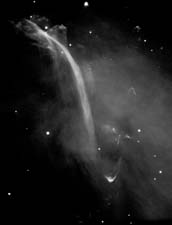Return to Index |
Previous Image |
Next Image |
Herbig-Haro objects were given their
name when George Herbig and Guillermo Haro discovered them (independently)
about 50 years ago. They are compact nebulae that exhibit a particular
spectra near dark clouds. They are now thought to be shock-excited nebulae
formed when young stars eject jets of material back into interstellar
space, smashing into nearby interstellar gas. Herbig-Haro objects are
found near carbon monoxide (CO) outflows, also a product of star formation
that occurs as a result of mass loss. They can move through the surrounding
interstellar gas at speeds of up to hundreds of kilometers per second.
Located in the Orion Nebula, Herbig-Haro 222 consists of many large arcs,
also known as streamers. All of the streamers come from the same point
southeast of the T Tauri star V571 Orionis, in a region of L1641, a region
that is rich in star formation. These streamers are found in the presence
of many newly-born, low mass stars. This suggests that a young, low-luminosity
star is at the core of the streamers. Note two bow-shock features placed
symmetrically with respect to the jet which is emerging from a young star
close to the center of the image. This jet and the two bow shocks are
also classified as Herbig Haro objects.
(Courtesy of the European Southern Observatory's Very Large Telescope).
References:
http://www.astroscu.unam.mx/scu/hh32hst.html
Animation of Contrast
Object |
Distance from Earth |
Wavelength |
Herbig-Haro 222 |
1,500
light years |
Optical |

